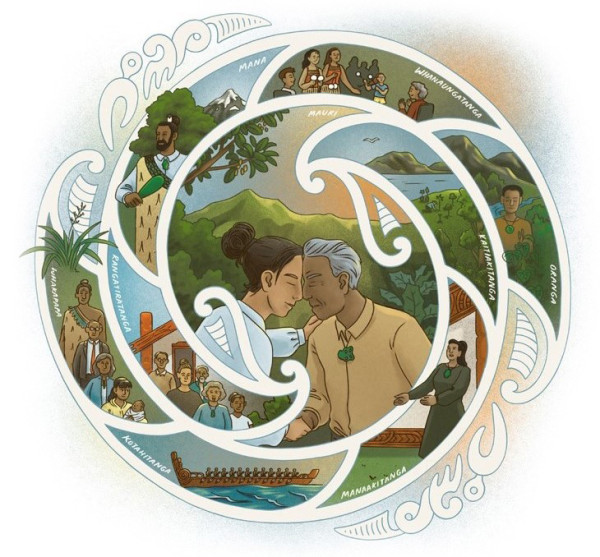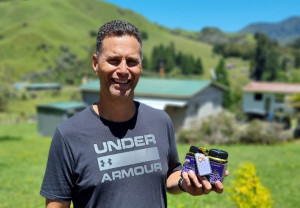Principles from te ao Māori the Māori worldview | He aronga Māori ki ngā mātāpono
Te ao Māori can help shape just transition processes to better address complex problems.
On this page
Te ao Māori emphasises the importance of relationships between nature and people. It is a holistic worldview that focuses on interconnections and is grounded in tikanga customary values and lore and mātauranga knowledge. Practices, values and principles from te ao Māori have been developed around marae to bring ancestors and communities together in one place in deep connection with whenua and taiao environment.
Tikanga
Tikanga provides guidance on how to do just transitions. Tikanga might be thought of as the right way of doing things according to conventions, rules or protocols that have helped kin communities in the past in terms of social, economic, political and environmental survival. Tikanga helps to ensure processes and decisions are just and fair. Tikanga includes principles of consensus building, respect, care, balance, intergenerational equity and relationship building.
Following these procedures can enable equitable, fair and resilient outcomes. Plans and actions need to be understood and supported by the community to be successful. Deeply inclusive, participatory and enabling procedures allow everyone affected by a decision to influence that decision. These procedures ensure that decisions are tika just.
“It will be our cultural practices – how we do things using ancient and adaptable intergenerational knowledge – that will shape and reclaim our natural world and replenish the mauri [life force] of our people, taonga [treasured species] and biodiversity.”
Harina Rupapera
Te Ara ki Kōpū | Te Arawa Climate Change Strategy(external link) — Te Arawa
Mātāpono principles
In Māori hapori, just transitions may be shaped by mātauranga and māramatanga enlightenment.

Text description of the mātāpono principles diagram
Below are 9 fundamental mātāpono that may guide processes for working together. The specific interpretations of each and what they mean within community contexts need to be defined by those communities themselves (as informed by tikanga).
Whakapapa
Whakapapa is understood as genealogy, lineage or descent. It derives from ‘papa’, literally meaning layer or layering so that, for instance, one generation is layered upon another. As an organising principle, it orders the universe, connecting time past to time present. It can also be like a whāriki mat that weaves hunga ora the living, hunga mate those who have passed on and te taiao into a complex matrix of relationships. Whakapapa underpins who we are and guides what we do. It can provide the scaffolding for just transition processes by guiding responsibilities in relation to people and te taiao. Whakapapa essentially provides a broad context for just transition behaviour and action.
Rangatiratanga
Rangatiratanga is sometimes understood as autonomy, sovereignty, self-determination or customary leadership. But at the heart of rangatiratanga is trusteeship. As trustees, rangatira leaders act in the best interests of their community to help secure long-term benefits, based on ancestral precedent. Rangatiratanga is primarily about service. We often think of rangatira as those in established positions, particularly now in terms of those occupying positions within legal entities or in office roles. This holds true for organisations that are usually set up under Crown statute. But rangatiratanga also operates in other places. One is on the marae, where kuia and kaumātua elders and pakeke adults fulfil their roles. The marae is the central cultural locale for rangatiratanga expression, but there are others as well.
Kaitiakitanga
Kaitiakitanga is guardianship of te taiao and its resources. At the heart of kaitiakitanga is the idea of reciprocity between human and environmental interactions, recognising how each can support the other. It reminds us about learning from ancestral ways of doing things and of living well within environmental limits, with the goal of leaving the environment in a good or better state for future generations. Kaitiakitanga can guide actions needed to restore, rejuvenate, manage or conserve. These actions may utilise the best of mātauranga, māramatanga and tikanga, together with western science and technology. Sometimes, though, through māramatanga, communities recognise that environmental systems may provide their own solutions. We simply need to leave lands or waters alone to heal.
Mauri
Mauri is the life force, metaphysical essence or energy within a system that supports interconnected vitality. Mauri is present in lands, waters and all living things. From this perspective, just transitions are normally needed because mauri is out of balance or broken. The main point of a just transition is usually to restore, rebalance or rejuvenate this mauri.
Mana
Mana, or the idea of customary authority, status, power or stance, can be thought of as specific to a community. Having mana aligns with a community’s responsibility or duty to look after and care for their rohe. Mana guides what a community’s responsibilities are and what is needed for success.
Manaakitanga
Manaakitanga is caring for the needs of others and showing kindness. It is outward looking. It is a process of showing support and is about inclusion, monitoring and participation in just transition processes. Manaakitanga is similar to tika, or doing what is right, and may also be concerned with fairness. Determining what is fair is not easy. It may require hard discussions when weighing up cultural, economic, political or other competing interests. Trade-offs may need to be made.
Oranga
Oranga means wellness, wellbeing and good health. This applies not only to people or communities, but also to lands, waters, habitats, ecosystems and environments. Oranga also emphasises the importance of taking a long-term view and acting now for intergenerational change. It is relevant to all just transition processes, reminding us that the health and wellbeing of people and te taiao is interwoven.
Kotahitanga
Kotahitanga means oneness or unity and expresses the idea of collective action or responsibility. There will not always be agreement on all things at all times, but alignment is needed on core kaupapa issues or plans. Those involved in a just transition need to have good problem-solving skills and an ability to recognise similarities and respect differences in perspectives or skills. The outcome of kotahitanga is the unification of possibly diverse interests into mutual interests and common goals to address a problem, moving towards better outcomes for the collective.
Whanaungatanga
Whanaungatanga, deriving from the word ‘whānau’, or family, is about building relationships and making connections. It creates a sense of belonging and helps people to work together for a common purpose. Whanaungatanga maintains community cohesion.
Revitalising Ruatāhuna through honey (Te Urewera)

Manawa Honey is at the heart of a revitalised Ruatāhuna, after many difficult decades for this community in Te Urewera. This business is run by the Tuhoe Tuawhenua Trust with a core vision of manaaki – service, consideration for others and reciprocity – for the whole community.
The honey business is a means to an end for providing income for the community. It supports the regeneration of the haukāinga marae community and the local ecosystem of ngahere bush, orchards and pasture. The business provides much needed pollination in the environment and local food systems. It also gives a koha gift of free honey to local homes and marae each year, and supplies honey to locals at reduced cost.
The trust works hard to empower its team to develop skills that can harness energy and provide future benefit to the local marae community, ultimately attracting rangatahi young people back home to engage in meaningful employment.
The Ruatāhuna community came together as a unified kin group to dream, guide and shape the economic and cultural kaupapa for the trust. In turn, the Tuawhenua Trust provided vision and focus through its honey business. It partnered with science experts at Manaaki Whenua Landcare Research, building the knowledge and skills of community members and providing employment.[1]
Photo credit: Manawa Honey
[1] 'Whāriki: The Growth of Māori Community Entrepreneurship', Kawharu, Merata, and Paul Tapsell. 2019. Auckland: Oratia Books.

